A mild winter means we are seeing a bunch more noxious weeds popping up early, or moving along faster than usual. As we keep getting rain, sun and mild temperatures, our noxious weed season is growing into a serious challenge! Here is just a small sample of the noxious weeds showing up in King County this March.
Garlic mustard is a Class A Noxious weed that is teetering on the edge of being out of control in King County and other parts of Washington. It is still being targeted for eradication because it could have significant impacts on native habitat if we don’t stop its spread. Help us spot it and stop it while we can! It’s edible to people but spreads rapidly in natural areas and crowds out native plants. It can easily be confused with many other plants including native plants like fringe cup and stinging nettles. Garlic mustard is just emerging now but will soon be bolting and flowering in April, if not before. Look for white flowers, scalloped-edge leaves that aren’t fuzzy, a garlicky smell and curved tap roots. This time of year we can find garlic mustard in many stages from seedling to rosette and even a few early flowers.

Garlic mustard leaves in February 
Garlic mustard seedlings in early March 
Garlic mustard new leaf emerging 
Garlic mustard plants in March 
Early garlic mustard flower in March
Giant hogweed, also a Class A noxious weed, is very dangerous to people due to its toxic sap that causes burns. In the spring, look for large, jagged-looking leaves growing in clumps and stems with stiff white hairs and purple bumps. In the summer, mature plants are topped by 10-15 foot tall stems topped by giant umbrella-shaped flower clusters. This exotic species is very similar to a native plant called cow parsnip, which is also emerging now. For help distinguishing them, send photos to our noxious weed specialists and we can help sort it out. Both plants have dangerous sap so make sure to wear gloves when handling either species.

Giant hogweed seedlings 
Large giant hogweed leaf 
Young hogweed leaf by glove in March 
Giant hogweed in March 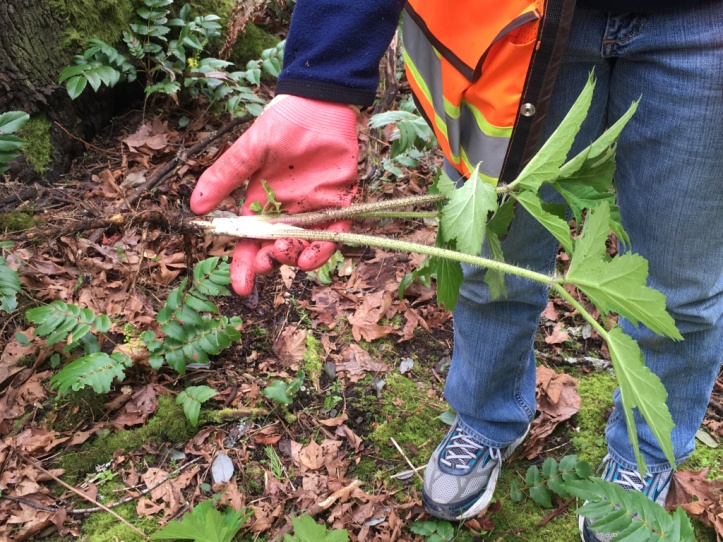
Small giant hogweed plant
Poison-hemlock is a Class B noxious weed (control required on public lands and roadways). We just covered this plant in this blog so I’ll keep it short and simply repeat that it is very poisonous and should be controlled where ever possible to prevent people from getting hurt. There are many look alikes when the plants are small, but poison-hemlock stems are not hairy and do have purple spots, so look for both characters to narrow it down.

Poison-hemlock infestation budding in March 
Poison-hemlock under a picnic table 
Poison-hemlock by the water in Seattle 
Poison-hemlock vs. western hemlock tree seedling 
Large poison-hemlock root 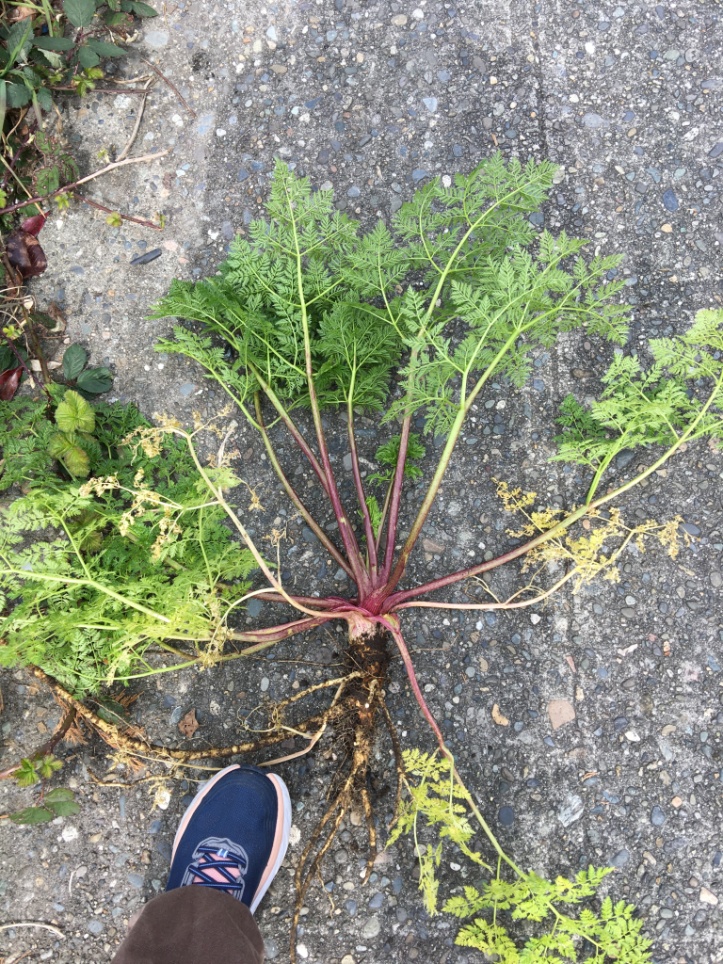
Poison-hemlock plant uprooted
Shiny geranium looks innocent until you see how invasive it can be. This is a Class B noxious weed in King County that we are fighting hard to contain. It can quickly spread by seed and form dense groundcover into native forests and creeksides, as well as backyard and roadsides. Small shiny leaves have sparse hairs on them but stems are shiny, especially compared with herb Robert or the common turf weed dovefoot geranium. Although it only spreads by seed, shiny geranium germinates several times a year. Every time you pull it, expect to find new plants in the same area in another month or two. Repeat visits to the same location is the only way to keep this plant at bay.
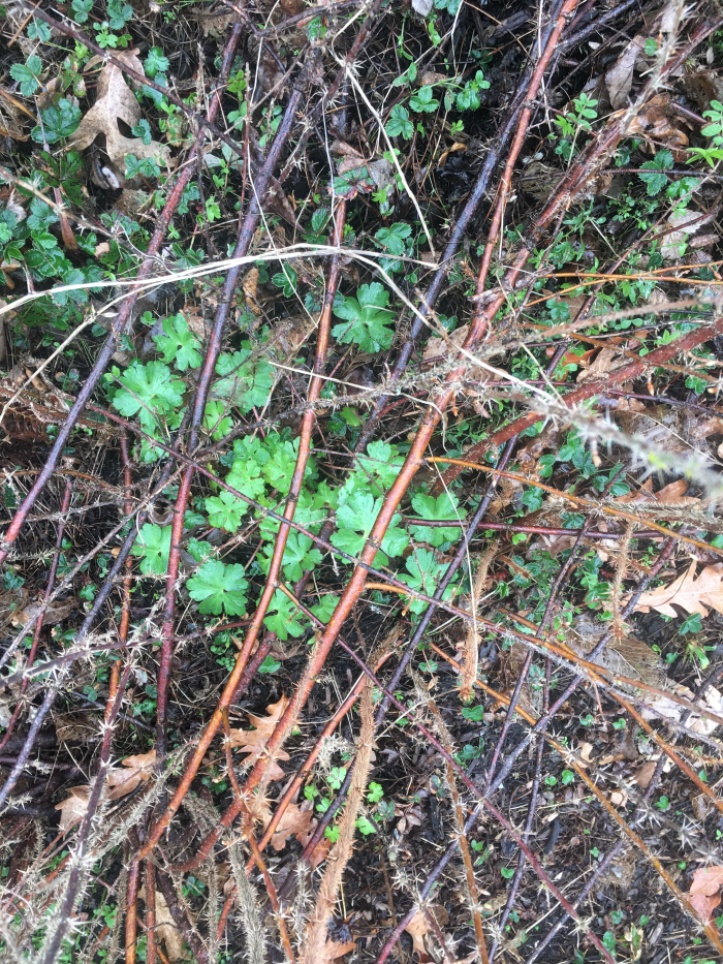
Shiny geranium hiding under thorny stems 
Shiny geranium stems are reddish and leaves are shiny with sparse hairs 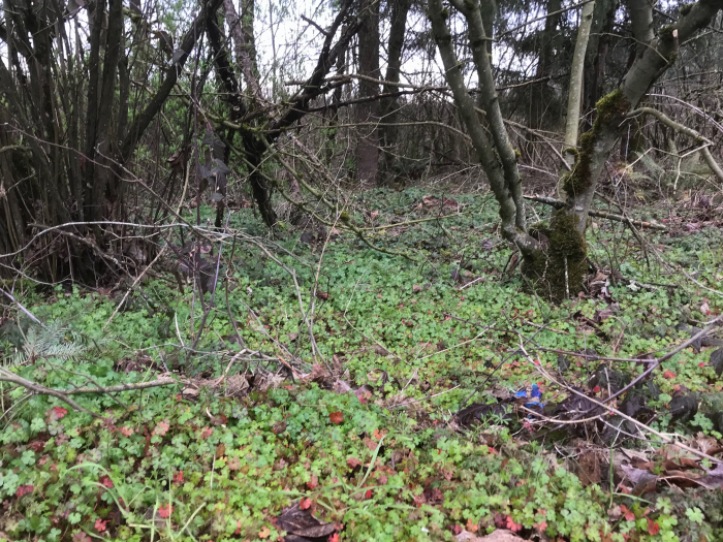
Shiny geranium infestation near Soos Creek
Spurge laurel is not a laurel or a spurge, but rather a Daphne. Spurge laurel is not that pretty, but it does have an ornamental look to it. However, don’t be fooled, it is very invasive and can form large infestations in parks and forests, especially in drier conditions. It has an irritating sap so use gloves when handling. You can dig up the plants or even pull out small ones, but that can be daunting if you have a giant patch of it. Spurge laurel is a very early bloomer with flowers appearing as early as February.
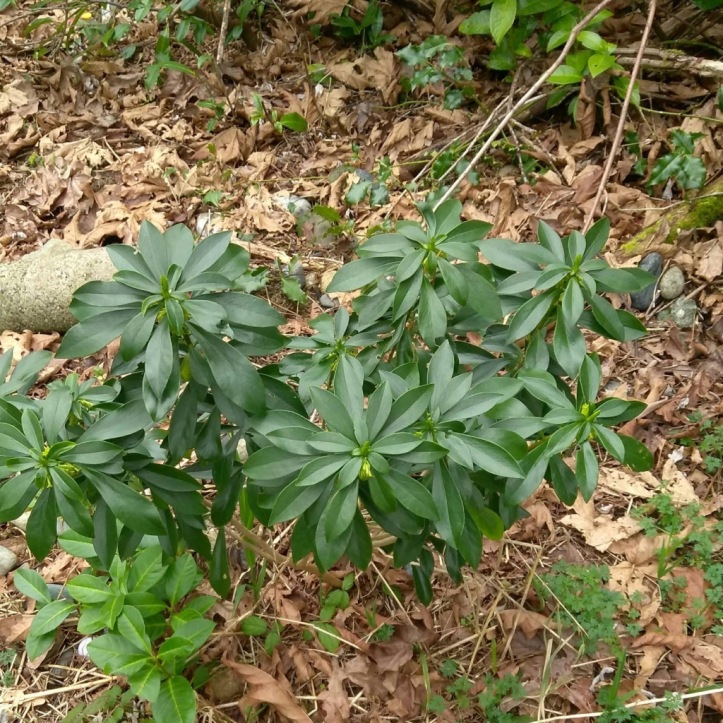
Spurge laurel in a Seattle park in March 
Spurge laurel in flower and with new growth in March
Lesser celandine is one of those plants that has fooled many people into planting it, or underestimating its impact. It’s a low-growing relative of the buttercup that forms dense patches. It emerges super early in the spring, is already in full flower in March and will be in seed by May, after which it dies back and goes dormant until the following year. It spreads by seeds, bulbils that form on the stems, and tubers that form on the roots. Once it’s in the soil, it is nearly impossible to get rid of without considerable effort and persistence. Unfortunately, it can be spread in topsoil and mulch so make sure your landscape materials are coming from a safe, weed-free provider.

Lesser celandine in January 
Lesser celandine infestation from contaminated topsoil 
Lesser celandine plants spread in topsoil 
Lesser celandine in flower 
Lesser celandine at Marra Farm in March
Italian arum is another plant that spreads in topsoil and mulch, possibly helped along by squirrels! It has attractive shiny leaves with white marbling that emerge in late winter to early spring and produces interesting looking stalks with red fruits in the summer. Sadly, it also has irritating and toxic compounds that can cause problems for people handling it and for animals eating it. Controlling it is very hard because of the numerous tubers it forms in the soil. The numerous tubers often fall off the roots when you pull the plants. It often shows up where yard waste is dumped, spreading out from there to take over in natural areas and parks.

Italian arum plants in early spring 
Italian arum at a yard waste dump site
Scotch broom is a very familiar invasive weed on the west coast and is so widespread people new to the area may think it’s a native plant (in spite of the name!). Scotch broom has become entrenched in this part of the world but it was originally brought here from Europe both as an ornamental species and for erosion control on slopes and roadsides. Scotch broom starts flowering about now but isn’t usually in full bloom until later in the spring. If you have allergies, Scotch broom in flower can trigger terrible headaches just from the odor alone. And don’t get me started on how long-lived the seeds are, how invasive it is, or how much of a fire hazard it is!

Early Scotch broom flowers in March 
Scotch broom flower up close 
Scotch broom infestation on a hillside
Gorse, a relative of Scotch broom but much meaner, is a Class B noxious weed with control required in King County because it is relatively limited here. Look for golden-yellow flowers starting in late February and stems covered with sharp, stout thorns. The bushes are large and dense, making control a big challenge. Gorse also contains a very flammable oil so it can create a big fire risk as well as being invasive.

Gorse spines up close 
Flowering gorse stem in February 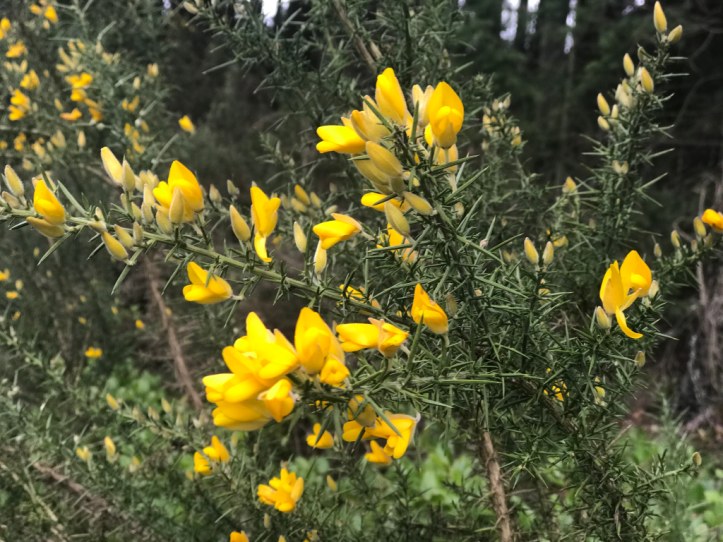
Flowering gorse stem in March 
Gorse plants in the woods near Fall City
European coltsfoot is a relatively new Class B noxious weed we are looking for and controlling in King County. It has the strange pattern of flowering in February on leafless stalks and then leaves emerge in spring after it starts to go to seed. By summer all you see are the leaves. It is similar to our native coltsfoot in how it grows, but European coltsfoot has yellow flowers and leaves that are not deeply lobed. Native coltsfoot has white flowers and deeply lobed leaves. European coltsfoot is showing up in two main areas in King County: natural lands near water where there is a lot of natural disturbance and gravel piles. The plant thrives on disturbance which allows it to fragment and spread by rhizomes. Although not that difficult to control individual plants, large infestations are difficult to eradicate because of this spread by rhizomes.

European coltsfoot flowers in February 
European coltsfoot on a gravel pile 
European coltsfoot infestation in the summer 
European coltsfoot new leaves in March
Spotted knapweed is just starting to grow this month. It tends to overwinter as a low-growing rosette and then produce flowering stems in the spring. Right now you will mostly see the rosettes which can be hard to spot. However, if a plant has grayish leaves around here, it’s probably not native, so take a closer look! Spotted knapweed leaves are so deeply lobed there’s really not much leaf surface left. Once it flowers, the stems are taller and topped by little pink-purple flower heads that resemble thistles but without the thorns. Spotted knapweed is a Class B noxious weed that is required for control in King County so we would love to know where you see it.

Spotted knapweed rosette in March 
Spotted knapweed stems before flowering
For more information about noxious weeds, visit the King County Noxious Weed Control Program or the Washington State Noxious Weed Board website.
Report noxious weeds in King County using the King County Connect mobile app or our website.
Report noxious weeds and other invasive species elsewhere in Washington using the WA Invasives app or by contacting your local noxious weed board.